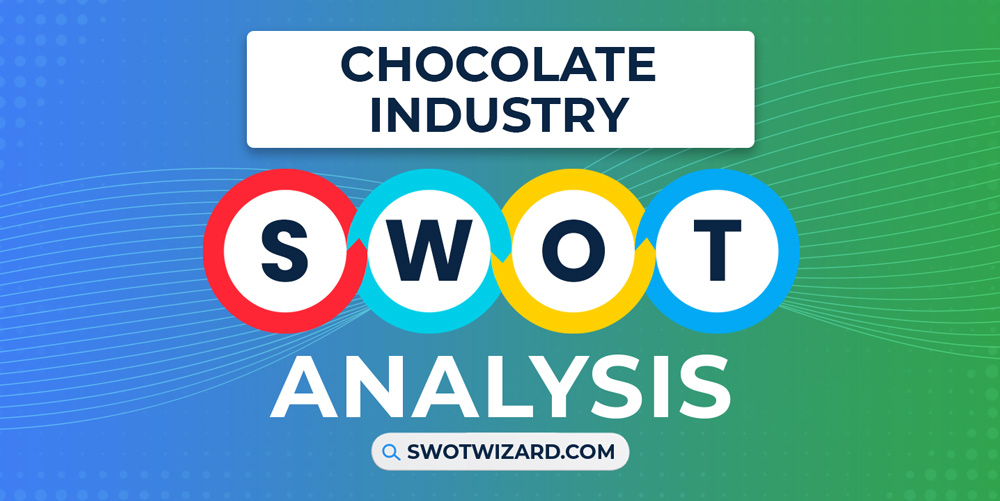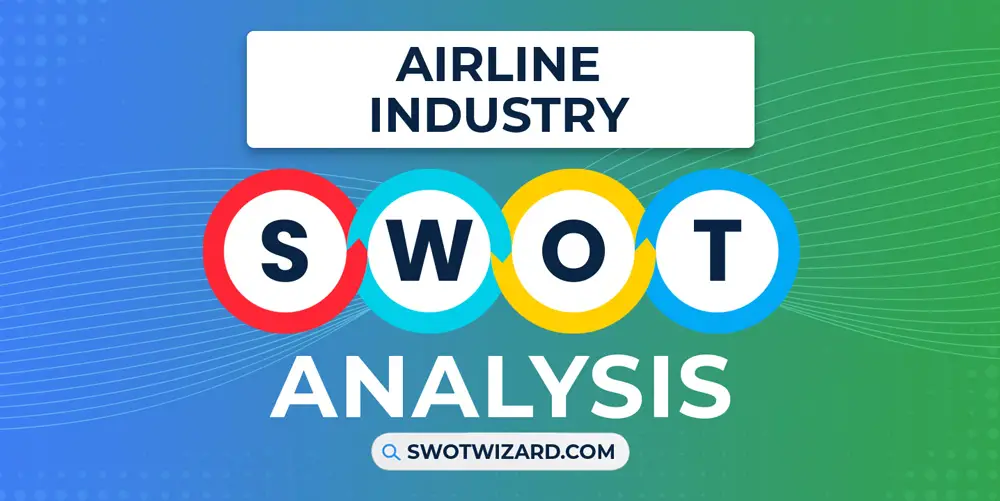The chocolate industry has always been part of our lives and has been a lifelong friend from childhood to age. We grew up with lots of chocolate-related memories, and in this chocolate industry SWOT analysis, we will learn about its business part.
Chocolate Industry Overview
The global chocolate confectionery industry traces back 2,000 years to the Mayan and Aztec civilizations, which consumed a bitter brew of fermented cacao beans. Commercial production later took off in the 1800s when innovations led by Cadbury, Hershey, and Nestle simplified mass manufacturing and distribution.
Fast forward to today, the industry generates over $111.97B in annual sales across 8M metric tons of annual consumption, and combined global employment for chocolate brands exceeds 600,000 people worldwide.
Competitors in Chocolate Industry
Mars | Mondelez | Nestle | Meiji | Hershey
Did You Know?
To make a single 70-gram Toblerone bar, cocoa sourced from Africa and honey from a Slovenian forest must pass through 8 countries across 3 continents.
Strengths – Chocolate Industry SWOT Analysis

Popularity: The industry and its products have immense global popularity as an affordable indulgence. Global chocolate sales reached approximately $111.97B, indicating strong and growing demand in 2023. Besides, stakeholders and brands leverage flavor, texture, and packaging innovations to maintain interest.
Global Presence: Major players like Mars, Ferrero, and Hershey have diversified their production and established sales in every habitable continent. If we look at the data, Hershey’s products are sold in over 80 countries, and combined with localized offerings, it allows tapping growth opportunities worldwide.
Strong Customer Base: As you can imagine, the chocolate industry has a strong, loyal, and growing customer base; as a matter of fact, approximately 7.5 M metric tons of chocolate was consumed in 2023, and it is growing. Besides, brand loyalty and gift-giving support repeat purchases, especially for leaders like Ferrero Rocher and Lindt, who make high-quality chocolates.
Weaknesses – Chocolate Industry SWOT Analysis
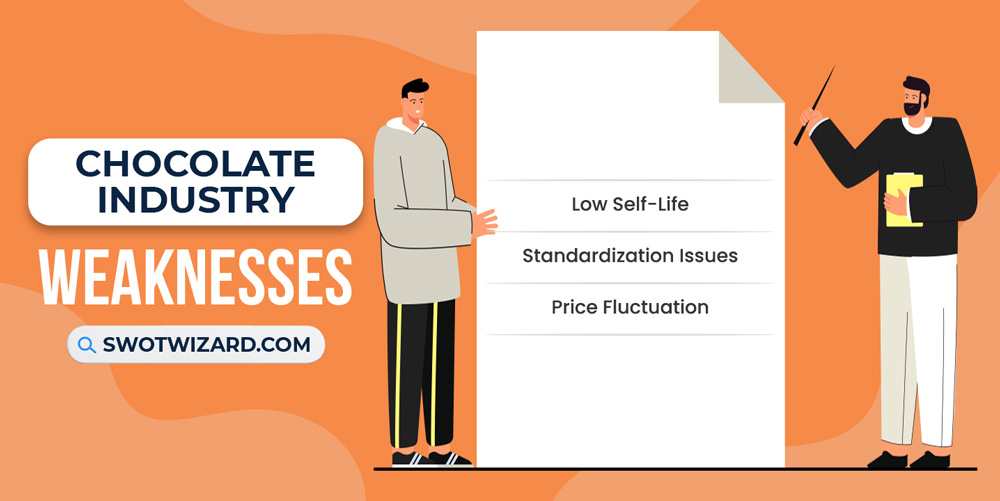
Low Self-Life: As you already might know, Chocolate has a relatively short shelf life compared to other packaged foods. According to data, milk and white chocolates last just 4-6 months, while dark chocolate lasts up to 2 years. Besides, precise temperature and humidity control are needed to increase costs.
Standardization Issues: Because of standardization issues, the lack of universal standards for cacao percentages confuses consumers. Tests show the amount of cacao solids printed on labels often deviates from actual values; according to reports from various sources, creating universal standards would increase transparency.
Price Fluctuation: There is a long process, and tons of factors are working behind this issue; often, cocoa bean prices are volatile due to crop disease, weather events, and geopolitical factors. According to the data, cocoa bean prices have risen over 25 percent in the last few years, and price spikes squeeze margins for chocolate makers.
Opportunities – Chocolate Industry SWOT Analysis

Exclusive Offerings: Premium and origin-specific cacao allow brands to release exclusive offerings, and we have seen these types of practices in the industry. Besides, the specialty chocolate market is growing steadily and is predicted to reach $49.97B by 2029. Not to mention, there are more opportunities, and emphasizing terroir and craft production positions chocolate more as a luxury.
Market Development: The world economy is booming, and developing markets provide expansion opportunities for global brands. According to the data, the chocolate market in many populated countries, including China, has grown 50% from 2019 to 2023. As a result, demand is rising across Asia and the Middle East, and adapting marketing and flavors to local tastes allows growth into these untapped markets.
Personalization: Customized and personalized chocolates present an opportunity to connect with customers, and as a result, Cadbury in India added birthdate imprinting, driving a 27% sales increase in the last few years. Besides, startups like Chocomize and Delysia let online buyers customize everything from fillings to packaging for gift-giving.
Threats – Chocolate Industry SWOT Analysis
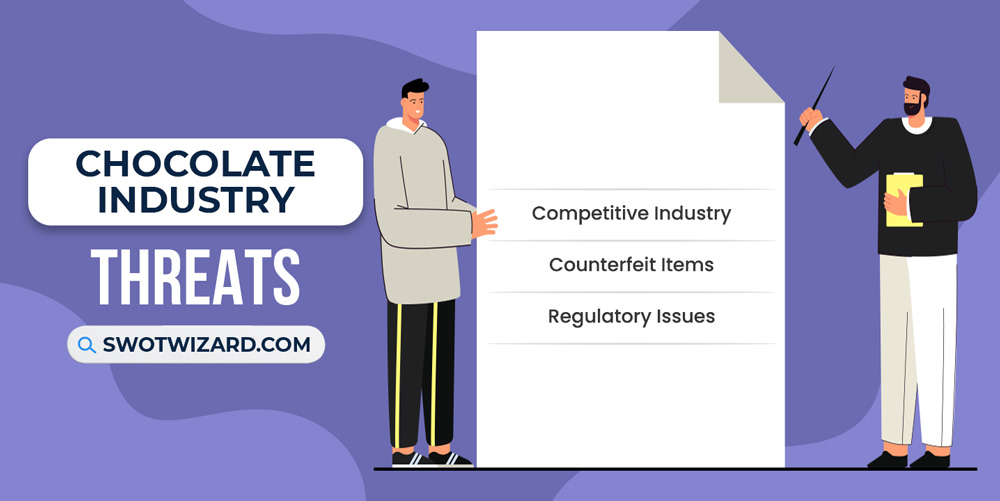
Competitive Industry: The global chocolate confectionery market is intensely competitive and concentrated. If we look at the data, the top five companies (Mars, Mondelez, Nestle, Meiji, and Hershey) represent over 60% of market share. As a result, high advertising costs pose barriers to entry, but startups still erode segments.
Counterfeit Items: If we look around us, tons of fake chocolate packets imitate famous brands, and lucrative brand names make chocolate prone to counterfeiting. According to the data, authorities seized over $50M in fake candy and chocolates across over 240 incidents from 2022 to 2023.
Regulatory Issues: Evolving government regulations worldwide threaten formulations and profitability for the industry’s stakeholders. There are many rules and regulations, such as the EU chocolate directive, which only allows products with higher cacao percentages to be labeled “chocolate.” As a result, brand communications and recipes may need adjustments to adhere to.
[Bonus Infographic] SWOT Analysis of Chocolate Industry
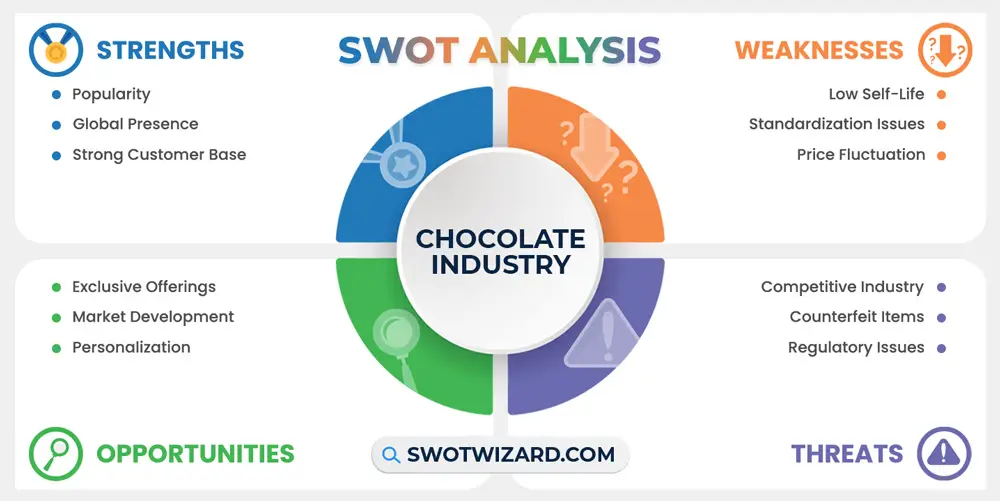
Recommendations for Chocolate Industry
Here are some recommendations for the chocolate industry for the coming days.
- Brands should invest in specialty cocoa bean sourcing, innovative flavor combinations, and enhanced packaging to attract higher-end consumers willing to pay more.
- With western markets maturing, global expansion in developing countries across Asia and the Middle East offers a significant avenue for increasing sales.
- Devote a brand marketing campaign that educates consumers on identifying authentic branded chocolate products versus fake counterparts.
- Offer customers more customization choices online and in stores through imprinting, specialized packaging, gift box options, and mixing their flavor combinations.
Frequently Asked Questions (FAQs)
Which country is famous for chocolate?
Germany, Belgium, and Italy are famous for chocolate.
What is the most luxurious chocolate brand?
Amedei Tuscany is the most luxurious chocolate brand.
Final Words on Chocolate Industry SWOT Analysis
The global chocolate industry enjoys continued popularity and a solid customer base but faces pricing volatility, competitive pressures, and supply chain vulnerability. Leveraging premiumization, emerging markets, sustainability initiatives, and e-commerce represent vital opportunities. At the same time, personalization, anti-counterfeiting measures, specialized innovation, and marketing authenticity will help mitigate risks from fakes and health trends.

